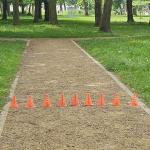Guest Blogger, Dr. Ann Randerson
May 20th is Whit Monday, Moon of Pentecostal In French, or Pink Star Monday It means “holiday after Pentecost Sunday” in Dutch or Flemish. It’s a bank holiday in Belgium, so all the shops were closed and most people didn’t have to work. It’s a holy day, a time when everyone rests and families get together to have picnics in their gardens, on the seaside or in the local park. In my village, mostly elderly people would walk the cobbled streets to attend morning mass. Others would do some spring cleaning, wash windows or polish their cars, but no mowing the lawn or trimming the hedges, because that’s forbidden on Sundays and public holidays in Belgium.
On Whit Monday, I took a walk in my local park for some fresh air and inspiration. Nature is a healthy option to combat stress and fatigue and it nourishes my soul. As I walked along the dirt path lined with sturdy trees, I noticed how lush the leaves were and how tall the grass was. It was uncommonly sunny and warm outside. Our winter had been unusually wet and cold.
Over the past few years, our commune or Aggregation (“Municipality” in English) decided not to mow the grass during May. This is to make the area bee-friendly and allow wildflowers to grow so that the bees can pollinate them. Recently, there has been a sharp decline in the bee population, which can be attributed to habitat loss, pesticides, and global climate change. I am pleased to say that most of the residents of my village are aware that pollination by insects, especially bees, is essential to ensure the biodiversity and sustainability of plants and crops. So they adhere to this informal rule, as evidenced by the calf-tall grass and blooming flowers in their yards.
Obstacles in my path
Yesterday, I was strolling through the park, enjoying the vibrant colors of the wild dandelions, daisies, bee balms, snapdragons, crocuses, lavender, foxgloves, cornflowers, and cosmos, when I saw a few families having a picnic in the sun. Then, a few yards away, I saw a young boy in a blue shirt. He looked just old enough to handle a bike, as was made clear by his zig-zagging in front of me down the narrow dirt path. He stopped suddenly, and I went around him to continue on my way. To my surprise, he stepped on the pedals, stumbled a little further next to me, then spun his wheel again, blocking my way. Startled, I stopped, glanced at his parents as they held up a volleyball net, and continued on my way around him. This happened again and again. Each time, he looked up at me with a broad grin.
“So that means we’re going to run an obstacle course,” I thought with a smile.
Changing direction: an unexpected discovery
We played together for a while, remembering how bored we were as a child, and I enjoyed the way his eyes lit up every time he blocked my way. Finally, either he got bored of playing, or I had gone too far and taken a right when my usual left turn was supposed to be. After a few steps, I spotted a plastic object buried in the grass next to a tree trunk. It looked like someone’s hearing aid charger, which made sense since I was near a local store. Russ House I went in to return it to the (Assisted Living Center for Seniors), but the reception was closed because it was a holiday. As I was leaving, I noticed a few pamphlets. One was about dementia, and others explained life at the center and the serviced apartments across the park. I was given a couple of pamphlets.
This discovery was timely, but I wanted to avoid thinking about it. My parents-in-law are getting older, and my father-in-law has lost much of his memory since his heart attack just a year ago. We had been putting off discussing what to do next. The pamphlet might help us make an important decision.
In fact, yesterday’s walk led to a meaningful discovery. As I rounded another corner, a boy on a wobbly bike smiled at me through the trees. This time, his whole family laughed as I passed his bike every time he skidded to a halt. After a while, I noticed orange cones up ahead. Someone had placed a row of small cone-shaped objects in the middle of the dirt path, presumably to keep the boy from cycling out of the park; a safety barrier from concerned people, perhaps his loving family.
My role as a spiritual director is to help my clients understand the spiritual meaning that permeates their lives, including the unexpected obstacles that arise along the way, and in my next post I’ll share more about how to do this.
Many thanks to Teresa Blythe for the opportunity to contribute to Spiritual Direction 101.
Dr. Ann Randerson She will graduate from the Phoenix Center for Spiritual Direction Apprenticeship Training Program in January 2024. She lives in Brussels, Belgium. She is a spiritual director, author, mindfulness-based transition coach, teacher of contemplative practice and creative expression, and a member of Spiritual Directors International (SDI). In 2003, Anne completed her PhD from Spiritual Directors International. Human Life Studies After six years of research in northern Japan, she wrote the following paper: Human Lifestyle and Sensitivity to Nature: A Comparative Study of Japan and the West from a Religious PerspectiveAnne has lived in five countries, speaks six languages, and currently offers online sessions to spiritual leaders of different faiths, cultures, languages, and backgrounds, particularly welcoming individuals from LGBTQIA+, neurodiverse (including ADHD), global and creative communities, and those facing chronic illness, grief, and loss. Anne also hosts interfaith group spiritual guidance, meditative nature-based retreats, and will soon be leading an international pilgrimage. To contact Anne, please visit: https://evocativesoul.com or email: info@evocativesoul.com.

Source: Spiritual Direction 101 – www.patheos.com




